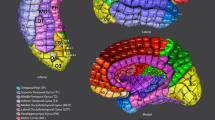Abstract
The stereological method of cross-counting based on the Cavalieri principle is widely used in neuroimaging to estimate the volume of cerebral structures. Although superficially simple, the stereological technique is validated by arcane mathematical proofs, so the cross size is determined by most investigators on a pragmatic basis with the assumption that the volume calculated is independent of the cross size used. We used three cross sizes (8×8, 5×5 and 3×3 voxels) to estimate the brain volume of six healthy control subjects. The volume estimate using a cross size of 3×3 was 9% larger than with a cross size of 5×5 and the latter was 15% larger than with a cross size of 8×8. We conclude that cross size significantly affects whole brain volume estimates and this result is presumably applicable to other structures whose cross-sectional areas form complex shapes. Investigators should be aware of this fact, especially when trying to make direct comparisons between volume estimates derived from the stereological method using different cross sizes.



Similar content being viewed by others
References
McDonald W, Husain M, Doriaswamy P, Figiel G, Boyko O, Krishnan K (1991) A magnetic resonance image study of age related changes in human putamen nuclei. Neuroreport 2: 57–60
Lisanby S, McDonald W, Massey W, Massey E, Doraiswamy P, Rozear M (1993) Diminished subcortical nuclei volumes in Parkinson's disease by MR imaging. J Neural Trans 40 [Suppl]: 13–21
Husain M, McDonald W, Doriswamy P, Figiel G, Na C, Escalona P (1991) A magnetic resonance imaging study of putamen nuclei in major depression. Neuroimaging 40: 95–99
MacFall J, Byrum C, Parashos I, Early B, Charles H, Chittilla V (1994) Relative accuracy and reproducibility of regional MRI brain volumes for point-counting methods. Psychiatr Res 55: 167–177
Axelson D, Doraiswamy P, Boyko O, Escalona P, McDonald W, Ritchie J (1992) In-vivo assessment of pituitary volume with magnetic resonance imaging and systematic stereology—relationship to dexamethasone suppression test results in patients. Psychiatr Res 44: 63–70
Sheline Y, Wang P, Gado M, Cseransky J, Vannier M (1996) Hippocampal atrophy in recurrent major depression. Proc Nat Acad Sci USA 93: 3908–3913
Sheline Y, Gado M, Price J (1998) Amygdala core nuclei are decreased in recurrent major depression. Neuroreport 9: 2023–2028
Keshaven M, Anderson S, Beckwith C, Nash K, Pettegrew J, Krishnan K (1995) A comparison of stereology and segmentation techniques for volumetric measurements of lateral ventricles in magnetic resonance imaging. Neuroimaging 61: 53–60
Vogels O, Zijlmans J, Van't Hof M, Thijssen H, Horstink M (1995) MR volume estimation of subcortical brain lesions and ventricular cerebrospinal fluid: a simple and accurate stereologic method. AJNR 16: 1441–1445
MacKay C, Roberts N, Mayes A, Downes J, Foster J, Mann D (1998) An exploratory study of the relationship between face recognition memory and the volumes of medial temporal lobe structures in healthy young males. Behav Neurol 5: 579–582
Escalona P, McDonald W, Doraiswamy P, Boyko O, Husain M, Figiel G (1991) In-vivo stereological assessment of human cerebellar volume: effects of gender and age. AJNR 12: 927–929
Sheline Y, Black K, Lin D, Christensen G, Gado M, Brunsden B (1996) Stereological MRI volumetry of the frontal lobe. Psychiatr Res 67: 203–214
Subsol G, Roberts N, Doran M, Thirion JP, Whitehouse G. (1997) Automatic analysis of cerebral atrophy. Magn Reson Imaging 15: 917–927
Cavalieri B (1966) Geometria degli indivisibili (1635). Unione Tipografico-Editrice Torinese, Turin
Roberts N, Puddephat M, McNulty V (2000) The benefit of stereology for quantitative radiology. Br J Radiol 73: 679–697
Gunderson H, Jensen E (1987) The efficiency of systematic sampling in stereology and its prediction. J Microscopy 147: 229–263
Robb R (1986) Analyze reference manual, v. 6.2. Mayo Clinic, Rochester MN
Grubb N, Fox K, Smith K, et al (2000) Memory impairment in out-of-hospital cardiac arrest survivors is associated with global reduction in brain volume, not focal hippocampal injury. Stroke 31: 1509–1514
Cotter D, Miszkiel K, Al-Sarraj A, Wilkinson I, Paley M, Harrison M, et al. (1999) The assessment of postmortem brain volume; a comparison of stereological and planimetric methodologies. Neuroradiology 41: 493–496
Acknowledgements
Many thanks to the expertise and patience of the radiographers at the Unit of Academic Radiology in the Royal Hallamshire Hospital. A special thanks to Dave Capener for being so accommodating while arranging the imaging.
Author information
Authors and Affiliations
Corresponding author
Rights and permissions
About this article
Cite this article
Dickson, J.M., Weavers, H.M., Mitchell, N. et al. Choice of cross size in stereology—a cautionary note. Neuroradiology 45, 896–899 (2003). https://doi.org/10.1007/s00234-003-1091-0
Received:
Accepted:
Published:
Issue Date:
DOI: https://doi.org/10.1007/s00234-003-1091-0




